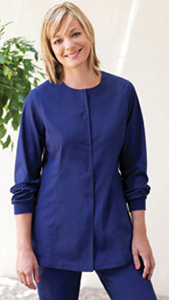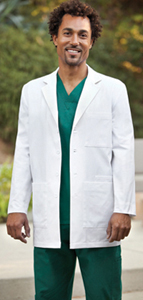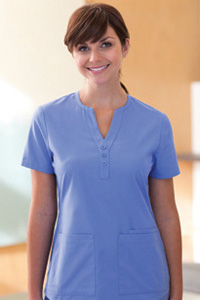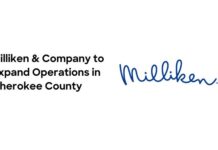|
M In addition, fabric technology enables manufacturers to focus more on the consumer, who today is working harder and trying to get greater value for the dollars they invest in their uniforms. New lines like ICU (intensive care uniforms) by Barco leverage technology to deliver unprecedented quality, fabric and style at an affordable price. The Elevation of Medical Apparel Scrubs were designed to be simple with minimal places for dirt to hide, easy to launder and disposable. As such, they typically were designed so that a few sizes fit all. A short-sleeve, boxy V-necked shirt and loose fitting pants with elastic waistbands or a short-sleeve calf-length dress were the norm by the 1970s. Scrubs were constructed with inexpensive cotton or cotton/polyester blend fabrics so they were cheap to replace if irreparably damaged or stained.
Since then, fashion and fabric technology have become major drivers in the evolution of medical apparel, with knits and 100 percent textured woven fabrics used for exceptional comfort and wash properties. And, in the 1990s, Barco Uniforms sparked a print and color revolution with the introduction of its Petite Floral line. Today, fabric technology continues to be a primary concern as wear and tear, demanding environments and grueling shifts present an even more intense challenge to create uniforms that work as hard as the professionals who wear them. In addition, an equally essential driver is the changing mindset of today’s professional. Designing with the wearer in mind is a must, and medical professionals demand scrubs that are stylish, enjoyable to wear, functional, fluid, high performance, affordable, durable and long-lasting. That’s a tough list to fulfill in a single garment. Love What You Wear To address this, leading uniform manufacturers embraced an influx of ideas and hired professionals from the consumer fashion industry. Designers approach scrubs aiming to make a desirable fashion statement with collections inspired by and incorporating the latest trends. Medical apparel is no longer a commodity where design is an afterthought, but is clothing that blends fashion and style without compromising functionality and performance. Today many collections are often branded with catchy names that reflect the heart of the professional. Others use licensed retail brand names like Grey’s Anatomy or Crayola that are reflections of current cultural trends.
The challenge is getting the costs of fabric innovations to a point that is not prohibitive, especially in today’s economy, which increases the emphasis on a garment’s worth. However, because of the advanced comfort and fit new medical apparel provides, employee performance can improve and medical organizations can gain from their investment. High-performance fabrics also help improve the durability of uniforms, a key consideration for individuals and companies. While a consumer may wear a favorite outfit a few times a year, uniforms are worn and washed much more frequently. It is vital that uniforms maintain their color and appearance because they project an organization’s brand and identity to the public and help professionals feel good about themselves as they serve others. These demands, in part, led Barco Uniforms to introduce its ground-breaking Advanced Research Clothing Technology (arcTechnology). Presently, arcTechnology comprises four unique fabric technologies: arcFlex, arcLux, arcRelease and arcDry, each specifically formulated to provide exceptional quality for professionals working in high-pressure, demanding environments where performance is critical. arcFlex is an exclusive fabric that stretches and moves with a person, leaving them looking and feeling their best through even the most difficult shift. It adapts to ease movement, freeing individuals to act quickly, and delivers an extraordinarily comfortable fit.arcLux is an ultra-soft fabric that wraps professionals with a feeling of luxury and pampers them even as they care for others. arcDry is specially formulated with superior moisture-wicking properties that help keep professionals dry and comfortable in virtually any situation. arcRelease is a premium, easy-care fabric with a soil-release finish that helps lift the most challenging stains. The secret to creating these high-performance fabrics is in the production and textile engineering processes. From the yarn filaments selected, the way filaments are processed before knitting or weaving into fabrics, the formula of how the product is dyed, the choice of dyeing equipment, to the different softener and treatments used, all are important factors in creating the right fabrics for different environments and uses. Fabrics with more technical finishes like arcTechnology can endure an enormous amount of stress and wear. In the end, these fabrics deliver on a personal level for medical professionals in terms of style and comfort as well as on a corporate level by enhancing brands, promoting professionalism and helping workers perform in a comfortable and effective manner. Case in point: ICU by Barco ICU by Barco features Barco Uniforms’ arcRelease, an exclusive fabric that delivers both softness and the soil-release performance needed to make easy work of even the toughest stains. In addition, the collection addresses the needs of the wearer with design elements like more pockets, practical Velcro and button closures, and a secure place to keep a phone or iPod. ICU by Barco includes selections for women and men in seven core colors. By fusing Barco Uniforms’ newest arcTechnology fabric and signature fit at an affordable price point, Barco Uniforms created a comprehensive collection that is ideal for virtually every medical professional, even those working in the most challenging healthcare environments. Gone are the days of commodity scrubs. By listening to and understanding the needs and wants of medical professionals, embracing consumer ideas and trends, and integrating fabric technology, apparel manufacturers have elevated scrubs to an entirely new level: medical apparel. In 2011, fashion-conscious consumers can take advantage of new advancements in fabric technology, style, comfort and increasingly affordable prices. As technology continues to advance and the lines between work wear and fashion blur, new collections are sure to debut that boost performance and ensure that professionals perform well while looking and feeling their best. Kyle Weiner has developed business and marketing strategies for some of the world’s leading footwear and apparel brands including Nike, Callaway Golf, K-Swiss and Easton-Bell Sports. He earned a degree in Political Science from the University of Colorado, Boulder. During his 11-year career with Nike, Kyle worked in Chile, Hong Kong and Germany. He founded KSW and Associates LLC, a firm dedicated to helping small businesses succeed by lending counsel and capital. Kyle joined Barco Uniforms in 2009 and today serves as Executive Vice President and COO. Since joining the company, he has been intimately involved in its brand identity re-launch project, working closely with customers, partners, suppliers and staff to ensure the brand reflects the passion and essence of the company as well as the future vision for the brand. |
| Above story first appeared in MADE TO MEASURE Magazine, Spring & Summer 2011 issue. All rights reserved. Photos appear by special permission. |
| UniformMarket, LLC 633 Skokie Rd., Suite 490 Northbrook, IL 60062 T: 224-406-8840 F: 224-406-8850 E: [email protected] |





 edical apparel is changing more aggressively and faster today than ever before, driven in part by a new breed of fashion-conscious consumers who are increasingly aware of fabric technology and who experience it firsthand in athletic apparel and outer wear, for example. In fact, traditional scrubs are being redefined and elevated to a new class of garment: clothing that is stylish and fashion-forward, designed for comfort and fit, and that utilizes the most advanced fabric technology available for built-in functionality and durability. The root of this evolution is technology, and increasingly companies like Barco Uniforms are identifying those developments relevant to the medical industry and using them as an essential element in design.
edical apparel is changing more aggressively and faster today than ever before, driven in part by a new breed of fashion-conscious consumers who are increasingly aware of fabric technology and who experience it firsthand in athletic apparel and outer wear, for example. In fact, traditional scrubs are being redefined and elevated to a new class of garment: clothing that is stylish and fashion-forward, designed for comfort and fit, and that utilizes the most advanced fabric technology available for built-in functionality and durability. The root of this evolution is technology, and increasingly companies like Barco Uniforms are identifying those developments relevant to the medical industry and using them as an essential element in design.

 Even so, as early as 1940 fashion began to be a significant factor in the design of medical apparel. Barco Uniforms was the first to address this, introducing a line of nursing uniforms that were both functional and flattering. New fabric technologies, like nylon and innovative fibers from Dupont, led to the design of nurses’ uniforms that were more graceful and feminine while improving performance and durability. An emphasis on style and fabric led to the use of the same fabrics and yarns used in fashion apparel; these enhanced comfort and enabled more fashionable uniforms.
Even so, as early as 1940 fashion began to be a significant factor in the design of medical apparel. Barco Uniforms was the first to address this, introducing a line of nursing uniforms that were both functional and flattering. New fabric technologies, like nylon and innovative fibers from Dupont, led to the design of nurses’ uniforms that were more graceful and feminine while improving performance and durability. An emphasis on style and fabric led to the use of the same fabrics and yarns used in fashion apparel; these enhanced comfort and enabled more fashionable uniforms. Yet the key to delivering this new class of medical apparel lies with fabric technologies. Widespread use of new technologies in consumer clothing from athletic apparel to outerwear have produced a more discerning consumer in the medical profession, a consumer who has come to know, understand and expect higher performance from fabric technology in their work apparel as well. They no longer view fabric finishes as things that simply increase the cost of the garment. There is an increased expectation for a wide range of functional finishes, ranging from moisture management to wrinkle-resistant technologies and fabrics with mechanical stretch, to anti-viral, anti-odor and UV protection technologies. An intimate understanding of each medical professional’s job function helps uniform manufacturers develop apparel lines that makes sense for wearers and is viable in the marketplace.
Yet the key to delivering this new class of medical apparel lies with fabric technologies. Widespread use of new technologies in consumer clothing from athletic apparel to outerwear have produced a more discerning consumer in the medical profession, a consumer who has come to know, understand and expect higher performance from fabric technology in their work apparel as well. They no longer view fabric finishes as things that simply increase the cost of the garment. There is an increased expectation for a wide range of functional finishes, ranging from moisture management to wrinkle-resistant technologies and fabrics with mechanical stretch, to anti-viral, anti-odor and UV protection technologies. An intimate understanding of each medical professional’s job function helps uniform manufacturers develop apparel lines that makes sense for wearers and is viable in the marketplace.







